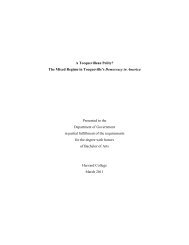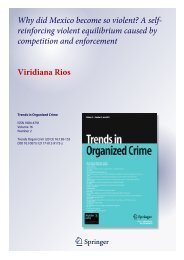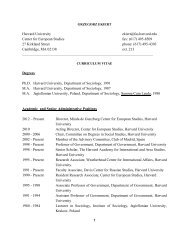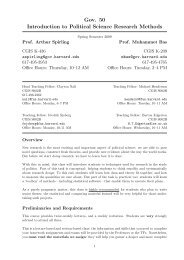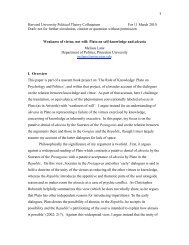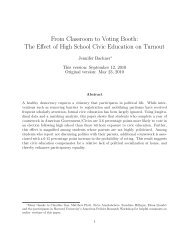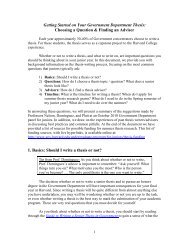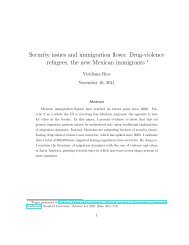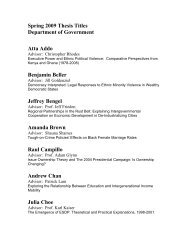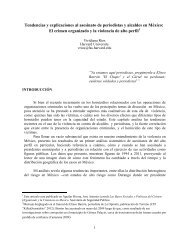Supreme Court Agenda Setting in a System of Shared Powers Ryan ...
Supreme Court Agenda Setting in a System of Shared Powers Ryan ...
Supreme Court Agenda Setting in a System of Shared Powers Ryan ...
You also want an ePaper? Increase the reach of your titles
YUMPU automatically turns print PDFs into web optimized ePapers that Google loves.
16 The Journal <strong>of</strong> Law, Economics, & Organization. V0 N0<br />
obta<strong>in</strong>ed by travel<strong>in</strong>g to the Library <strong>of</strong> Congress and search<strong>in</strong>g through the papers<br />
<strong>of</strong> former Justices Blackmun, Brennan, Burton, Douglas, and Warren. 24<br />
These data span the 1953-1985 <strong>Court</strong> terms. My source for the 1986-1993<br />
terms come from Epste<strong>in</strong>, Segal and Spaeth (2007). To control for the political<br />
salience <strong>of</strong> the case, I exam<strong>in</strong>ed the activity <strong>of</strong> organized <strong>in</strong>terests at the<br />
<strong>Court</strong>’s agenda stage. That is, Amici is a count <strong>of</strong> the total number <strong>of</strong> amicus<br />
curiae briefs filed both <strong>in</strong> support <strong>of</strong> and <strong>in</strong> opposition to the petition for certiorari<br />
(Caldeira and Wright, 1988). Dissent Below takes on a value <strong>of</strong> 1 if the<br />
pool memo <strong>in</strong> the case notes a dissent <strong>in</strong> the court below; 0 otherwise. Reverse<br />
Below equals 1 if the <strong>in</strong>termediate court reversed the trial court; 0 otherwise.<br />
Additionally, I code Conflict Below as 1 if the cert pool writer noted a conflict<br />
<strong>in</strong> the lower courts over the correct <strong>in</strong>terpretation and/or application <strong>of</strong> federal<br />
law; 0 otherwise. I also controlled for the position <strong>of</strong> the Solicitor General. If<br />
the SG requests review be granted (either as petitioner or as an amici advocat<strong>in</strong>g<br />
the grant <strong>of</strong> review), US Support takes on a value <strong>of</strong> 1; 0 otherwise. If<br />
the SG was respondent or filed an amicus brief oppos<strong>in</strong>g review, US Oppose<br />
takes on a value <strong>of</strong> 1; 0 otherwise. 25 F<strong>in</strong>ally, I exam<strong>in</strong>e whether the lower court<br />
struck down the federal statute at issue. If so, Lower <strong>Court</strong> Strike takes on a<br />
value <strong>of</strong> 1; 0 otherwise.<br />
6. Results<br />
Figure 4 presents the results <strong>of</strong> the SOP model for each theory <strong>of</strong> legislative<br />
decision mak<strong>in</strong>g. The solid circles are the parameter estimates and the horizontal<br />
l<strong>in</strong>es represent the 95 percent confidence <strong>in</strong>tervals for those estimates based<br />
on robust standard errors. As Figure 4 shows, the coefficient on Constra<strong>in</strong>ed<br />
<strong>Court</strong> <strong>in</strong> every model <strong>of</strong> legislative decision mak<strong>in</strong>g is not statistically significant.<br />
Take first the Chamber Median model. This model argued that when the<br />
<strong>Court</strong> was more liberal than the status quo, the House and Senate chamber<br />
medians, and the president, it would strategically decl<strong>in</strong>e to review the case.<br />
The results, however, do not support such an <strong>in</strong>ference. While the coefficient<br />
on Constra<strong>in</strong>ed <strong>Court</strong> <strong>in</strong> the Chamber Median model is negative, it does not<br />
approach conventional levels <strong>of</strong> statistical significance. That is, regardless <strong>of</strong><br />
the ideological location <strong>of</strong> the status quo <strong>in</strong> relation to the House, Senate, and<br />
President, the <strong>Court</strong> grants review, even while controll<strong>in</strong>g for the factors most<br />
commonly associated with review. What is more, <strong>in</strong> the Party Gatekeep<strong>in</strong>g<br />
model, Committee Gatekeep<strong>in</strong>g model, and Filibuster-Veto model, the coefficient<br />
(while not statistically significant) is signed <strong>in</strong> the positive direction. In<br />
short, the <strong>Court</strong> granted review to cases without regard to how a shift <strong>in</strong> the status<br />
quo would effect Congress and the president–and it did so <strong>in</strong> every model<br />
24. For terms prior to the adoption <strong>of</strong> the cert pool, I read through the cert memos written by<br />
Justices Burton’s and Douglas’s law clerks.<br />
25. The <strong>Court</strong> sometimes calls for the views <strong>of</strong> the Solicitor General at which po<strong>in</strong>t the SG’s<br />
<strong>of</strong>fice essentially is forced to make a recommendation <strong>in</strong> the case (Black and Owens, 2008). Controll<strong>in</strong>g<br />
for <strong>in</strong>vitations does not change my results.



